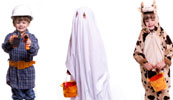 Teacher
Guide To Halloween
Teacher
Guide To Halloween
Halloween is celebrated on October 31st every year. The holiday began as a Celtic festival from Ireland called Samhain. Halloween became more popular world wide with the start of the Christian holiday called All Saints Day. Halloween is traditionally a holiday that is meant to ward off evil spirits. During the time of the Celtic traditions, people would carve out scary faces and figures in giant turnips, place a candle inside, and set in their windows to scare away evil ghosts and enemies on Halloween.
Nowadays the turnips have been replaced by orange pumpkins, but the carving tradition is still continued, as well as lighting the pumpkins on the night of Halloween. The traditional colors that are used for most decorations for Halloween are black and orange. There are certain characters that are associated with Halloween: ghosts, witches, skeletons, vampires, werewolves, bats and black cats.
People celebrate Halloween by going trick-or-treating, which means to get dressed up in costumes to look like traditional characters, such as witches or ghosts, and travel from house to house and say "trick or treat." If the house is friendly they will give treats to those dressed in costumes, such as candy or small toys. However, if the house does not give them any goodies, then the trick-or-treaters will play tricks on them, such as decorating the yard with toilet paper or eggs. Many of the homes will already be decorated with scary graveyards or fake spider webs to scare away evil spirits, as well as children who are trying to play pranks.
Most people who celebrate this holiday enjoy throwing costume parties where all the guests are dressed up in the traditional characters of Halloween. Often there are costume contests to judge who has the best outfit. Apple bobbing, a tradition that involves floating apples in water and participants attempting to grab the apple with only their mouth, is popular for Halloween. Many children and adults get together and tell ghost stories and spooky tales to scare one another while they eat the candies they collected during trick-or-treating.
Some religious groups do not celebrate Halloween because they feel it goes against their religious beliefs as a way of worshiping evil. For instance, Jehovah's Witnesses do not acknowledge Halloween and the children of this religious group do not go trick-or-treating or wear costumes. In Mexico, the Day of the Dead is often confused with Halloween because it falls the day after Halloween and celebrates the dead in their communities. However, this holiday is not the same as Halloween, and has its own customs, traditions and meaning. The Day of the Dead is a joyous celebration filled with parades, food and music as people reconnect with their loved ones who are dead, while Halloween is meant to scare off dead people and evil spirits. Halloween is more of a dark tradition with the idea that some spirits and ghosts come back around that time to scare or hurt people. However, most people do not really worry about the scary parts of Halloween and instead enjoy eating the candies, wearing the crazy costumes and spending time with friends and family while they visit others in their community.
Related Teacher Resources That Are Worth A Look:
- Halloween Classroom Ideas
- Humphrey The Blue-Nosed Pumpkin
- Jack-O-Lantern
- Pumpkin
- Old Witch
- First Day of Halloween
- Pumpkin Bells
- We Three Ghosts